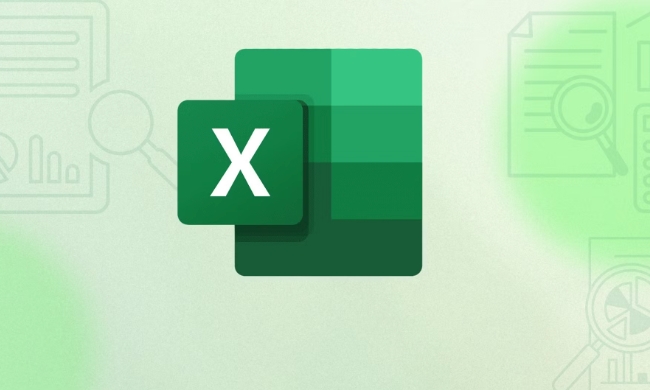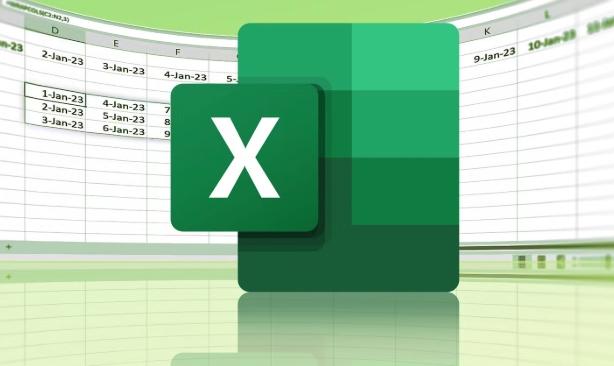To calculate working days between two dates in Excel, use the WORKDAY or WORKDAY.INTL function. 1. Use WORKDAY with a start date and workdays to add/subtract, e.g., =WORKDAY(A1,5). 2. For custom weekends, apply WORKDAY.INTL with a weekend code or string like "0000011". 3. Include holidays by adding a holiday range, e.g., B1:B5. Ensure dates are valid, formatted correctly, and holiday lists are accurate to avoid errors.

If you need to calculate working days between two dates in Excel, the WORKDAY function is a solid tool. It helps you skip weekends and even holidays if needed. Here’s how to use it effectively.

Basic Use of WORKDAY
At its core, WORKDAY calculates a date that is a certain number of workdays ahead or behind a start date. The default setup assumes a Monday–Friday workweek.
To use it, you just need two things: a start date and the number of workdays to add (or subtract). For example:

=WORKDAY(A1, 5)
This means: starting from the date in cell A1, give me the date 5 workdays later. If A1 is a Monday, the result will be Friday.
You can also use negative numbers to go backward. Like this:
=WORKDAY(A1, -3)gives you the date 3 workdays before A1.
One thing to remember: make sure your cell is formatted as a date, or you’ll see a serial number instead of a readable date.

Custom Weekends with WORKDAY.INTL
If your schedule doesn’t follow the standard Mon–Fri pattern—say, you work Tue–Sat or have a 4-day week—you should use WORKDAY.INTL. This version lets you define which days are weekends.
The syntax looks like this:
=WORKDAY.INTL(start_date, days, [weekend], [holidays])
The key part here is the [weekend] argument. You can either use a preset code (like 11 for Sunday only, 17 for Saturday only) or a custom string of 7 digits (1s and 0s) representing each day of the week.
For instance:
"0000011"means Saturday and Sunday are weekends."1000000"means Monday is the only weekend day.
So if you want to move 4 workdays forward from A1, but your weekend is Thursday and Friday, you’d write:
=WORKDAY.INTL(A1, 4, "0011000")
Adding Holidays
Both WORKDAY and WORKDAY.INTL can account for holidays. Just provide a range or list of holiday dates as the last argument.
Say your company has holidays listed in cells B1:B5. Your formula might look like:
=WORKDAY(A1, 10, B1:B5)
Or with WORKDAY.INTL:
=WORKDAY.INTL(A1, 10, 1, B1:B5)
Here, 1 sets the weekend as Sat–Sun by default. Make sure the holiday list includes actual dates and no extra text or blanks, or the function might throw an error.
A few tips:
- Dates must be valid Excel dates (not text).
- Holidays should be in chronological order, though it usually still works if they’re not.
- Always double-check that your holiday range is absolute (e.g.,
$B$1:$B$5) if you plan to copy the formula down a column.
That’s basically all you need to get started with the WORKDAY function. It’s not complicated, but small mistakes—like wrong date formats or missing holidays—can throw off your results.
The above is the detailed content of how to use the workday function in excel. For more information, please follow other related articles on the PHP Chinese website!

Hot AI Tools

Undress AI Tool
Undress images for free

Undresser.AI Undress
AI-powered app for creating realistic nude photos

AI Clothes Remover
Online AI tool for removing clothes from photos.

Clothoff.io
AI clothes remover

Video Face Swap
Swap faces in any video effortlessly with our completely free AI face swap tool!

Hot Article

Hot Tools

Notepad++7.3.1
Easy-to-use and free code editor

SublimeText3 Chinese version
Chinese version, very easy to use

Zend Studio 13.0.1
Powerful PHP integrated development environment

Dreamweaver CS6
Visual web development tools

SublimeText3 Mac version
God-level code editing software (SublimeText3)

Hot Topics
 How to Use Parentheses, Square Brackets, and Curly Braces in Microsoft Excel
Jun 19, 2025 am 03:03 AM
How to Use Parentheses, Square Brackets, and Curly Braces in Microsoft Excel
Jun 19, 2025 am 03:03 AM
Quick Links Parentheses: Controlling the Order of Opera
 How to insert date picker in Outlook emails and templates
Jun 13, 2025 am 11:02 AM
How to insert date picker in Outlook emails and templates
Jun 13, 2025 am 11:02 AM
Want to insert dates quickly in Outlook? Whether you're composing a one-off email, meeting invite, or reusable template, this guide shows you how to add a clickable date picker that saves you time. Adding a calendar popup to Outlook email
 Outlook Quick Access Toolbar: customize, move, hide and show
Jun 18, 2025 am 11:01 AM
Outlook Quick Access Toolbar: customize, move, hide and show
Jun 18, 2025 am 11:01 AM
This guide will walk you through how to customize, move, hide, and show the Quick Access Toolbar, helping you shape your Outlook workspace to fit your daily routine and preferences. The Quick Access Toolbar in Microsoft Outlook is a usefu
 Prove Your Real-World Microsoft Excel Skills With the How-To Geek Test (Intermediate)
Jun 14, 2025 am 03:02 AM
Prove Your Real-World Microsoft Excel Skills With the How-To Geek Test (Intermediate)
Jun 14, 2025 am 03:02 AM
Whether you've secured a data-focused job promotion or recently picked up some new Microsoft Excel techniques, challenge yourself with the How-To Geek Intermediate Excel Test to evaluate your proficiency!This is the second in a three-part series. The
 How to Delete Rows from a Filtered Range Without Crashing Excel
Jun 14, 2025 am 12:53 AM
How to Delete Rows from a Filtered Range Without Crashing Excel
Jun 14, 2025 am 12:53 AM
Quick LinksWhy Deleting Filtered Rows Crashes ExcelSort the Data First to Prevent Excel From CrashingRemoving rows from a large filtered range in Microsoft Excel can be time-consuming, cause the program to temporarily become unresponsive, or even lea
 How to Switch to Dark Mode in Microsoft Excel
Jun 13, 2025 am 03:04 AM
How to Switch to Dark Mode in Microsoft Excel
Jun 13, 2025 am 03:04 AM
More and more users are enabling dark mode on their devices, particularly in apps like Excel that feature a lot of white elements. If your eyes are sensitive to bright screens, you spend long hours working in Excel, or you often work after dark, swit
 Microsoft Excel Essential Skills Test
Jun 12, 2025 pm 12:01 PM
Microsoft Excel Essential Skills Test
Jun 12, 2025 pm 12:01 PM
Whether you've landed a job interview for a role that requires basic Microsoft Excel skills or you're looking to solve a real-world problem, take the How-To Geek Beginner Excel Test to verify that you understand the fundamentals of this popular sprea
 Google Sheets IMPORTRANGE: The Complete Guide
Jun 18, 2025 am 09:54 AM
Google Sheets IMPORTRANGE: The Complete Guide
Jun 18, 2025 am 09:54 AM
Ever played the "just one quick copy-paste" game with Google Sheets... and lost an hour of your life? What starts as a simple data transfer quickly snowballs into a nightmare when working with dynamic information. Those "quick fixes&qu






